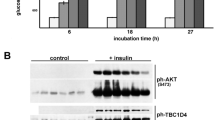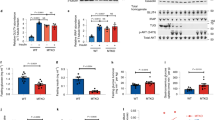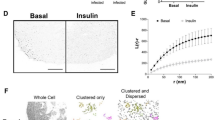Abstract
The stimulation of glucose uptake by insulin in muscle and adipose tissue requires translocation of the GLUT4 glucose transporter protein from intracellular storage sites to the cell surface1,2,3,4,5,6. Although the cellular dynamics of GLUT4 vesicle trafficking are well described, the signalling pathways that link the insulin receptor to GLUT4 translocation remain poorly understood. Activation of phosphatidylinositol-3-OH kinase (PI(3)K) is required for this trafficking event, but it is not sufficient to produce GLUT4 translocation7. We previously described a pathway involving the insulin-stimulated tyrosine phosphorylation of Cbl, which is recruited to the insulin receptor by the adapter protein CAP8,9. On phosphorylation, Cbl is translocated to lipid rafts. Blocking this step completely inhibits the stimulation of GLUT4 translocation by insulin10. Here we show that phosphorylated Cbl recruits the CrkII–C3G complex to lipid rafts, where C3G specifically activates the small GTP-binding protein TC10. This process is independent of PI(3)K, but requires the translocation of Cbl, Crk and C3G to the lipid raft. The activation of TC10 is essential for insulin-stimulated glucose uptake and GLUT4 translocation. The TC10 pathway functions in parallel with PI(3)K to stimulate fully GLUT4 translocation in response to insulin.
This is a preview of subscription content, access via your institution
Access options
Subscribe to this journal
Receive 51 print issues and online access
$199.00 per year
only $3.90 per issue
Buy this article
- Purchase on Springer Link
- Instant access to full article PDF
Prices may be subject to local taxes which are calculated during checkout





Similar content being viewed by others
References
Min, J. et al. Synip: a novel insulin-regulated syntaxin 4-binding protein mediating GLUT4 translocation in adipocytes. Mol. Cell 3, 751–760 (1999).
Olson, A. L., Knight, J. B. & Pessin, J. E. Syntaxin 4, VAMP2, and/or VAMP3/ cellubrevin are functional target membrane and vesicle SNAP receptors for insulin-stimulated GLUT4 translocation in adipocytes. Mol. Cell. Biol. 17, 2425–2435 (1997).
Hausdorff, S. F., Bennett, A. M., Neel, B. G. & Birnbaum, M. J. Different signaling roles of SHPTP2 in insulin-induced GLUT1 expression and GLUT4 translocation. J. Biol. Chem. 270, 12965–12968 (1995).
Elmendorf, J. S., Chen, D. & Pessin., J. E. Guanosine 5′-O-(3-thiotriphosphate) stimulation of GLUT4 translocation is tyrosine kinase-dependent. J. Biol. Chem. 273, 13289–13296 (1998).
Holman, G. D. et al. Cell surface labeling of glucose transporter isoform GLUT4 by bis-mannose phospholabel. Correlation with stimulation of glucose transport in rat adipose cells by insulin and phorbol ester. J. Biol. Chem. 265, 181172–18179 (1990).
Piper, R. C., Hess, L. J. & James, D. E. Differential sorting of two glucose transporters expressed in insulin-sensitive cells. Am. J. Physiol. 260, C570–580 (1991).
Pessin, J. E. & Saltiel, A. R. Signaling pathways in insulin action: molecular targets of insulin resistance. J. Clin. Invest. 106, 165–169 (2000).
Ribon, V. & Saltiel, A. R. Insulin stimulates tyrosine phosphorylation of the proto-oncogene product of c-Cbl in 3T3-L1 adipocytes. Biochem. J. 324, 839–845 (1997).
Ribon, V., Printen, J. A., Hoffman, N. G., Kay, B. K. & Saltiel, A. R. A novel, multifunctional c-Cbl binding protein in insulin receptor signaling in 3T3-L1 adipocytes. Mol. Cell. Biol. 18, 872–879 (1998).
Baumann, C. A. et al. CAP defines a second signaling pathway required for insulin-stimulated glucose transport. Nature 407, 202–207 (2000).
Aspenstrom, P. Effectors for the rho GTPases. Curr. Opin. Cell Biol. 11, 95–102 (1999).
Kjoller, L. & Hall, A. Signaling to rho GTPases. Exp. Cell. Res. 253, 166–179 (1999).
Neudauer, C. L., Joberty, G., Tatsis, N. & Macara, I. G. Distinct cellular effects and interactions of the rho-family GTPase TC10. Curr. Biol. 8, 1151–1160 (1998).
Jou, T. S., Schneeberger, E. E. & Nelson, W. J. Structual and functional regulation of tight junctions by rhoA and rac1 small GTPases. J. Cell Biol. 142, 101–115 (1998).
Benard, V., Bohl, B. P. & Bokoch, G. M. Characterization of rac and cdc42 activation in chemoattractant-stimulated human neutrophils using a novel assay for active GTPases. J. Biol. Chem. 274, 13198–13204 (1999).
Owen, D., Mott, H. R., Laue, E. D. & Lowe, P. N. Residues in cdc42 that specify binding to individual CRIB effector proteins. Biochemistry 39, 1243–1250 (2000).
Thompson, G., Owen, D., Chalk, P. A. & Lowe, P. N. Delineation of the cdc42/rac-binding domain of p21-activated kinase. Biochemistry 37, 7885–7891 (1998).
Wiese, R. J., Mastick, C. C., Lazar, D. F. & Saltiel, A. R. Activation of mitogen-activated protein kinase and PI 3-kinase is not sufficient for the hormonal stimulation of glucose uptake, lipogenesis, or glycogen synthesis in 3T3-L1 adipocytes. J. Biol. Chem. 270, 3442–3446 (1995).
Isakoff, S. J. et al. The inability of PI 3-kinase activation to stimulate GLUT4 translocation indicates additional signaling pathways are required for insulin-stimulated glucose uptake. Proc. Natl Acad. Sci. USA 92, 10247–10251 (1995).
Guilherme, A. & Czech, M. P. Stimulation of IRS-1-associated PI 3-kinase and Akt/ protein kinase B but not glucose transport by beta 1 integrin signaling in rat adipocytes. J. Biol. Chem. 273, 33119–33122 (1998).
Okada, T., Kawano, Y., Sakakibara, T., Hazeki, O. & Ui, M. Essential role of PI 3-kinase in insulin-induced glucose transport and antilipolysis in rat adipocytes. Studies with a selective inhibitor wortmannin. J. Biol. Chem. 269, 3568–3573 (1994).
Madge, L. A. & Pober, J. S. A PI-3 kinase/Akt pathway, activated by TNF or IL-1 inhibits apoptosis but not activate NF kappa B in human endothelial cells. J. Biol. Chem. 275, 15458–15465 (2000).
Knudsen, B. S., Feller, S. M. & Hanafusa, H. Four proline-rich sequences of the guanine-nucleotide exchange factor C3G bind with unique specificity to the first Src homology 3 domain of crk. J. Biol. Chem. 269, 32781–32787 (1994).
Gotoh, T. et al. Identification of Rap1 as a target for the crk SH3 domain binding guanine nucleotide-releasing factor C3G. Mol. Cell. Biol. 15, 6746–6753 (1995).
Omata, W., Shibata, H., Kuniaki, L. L. & Kojima, I. Actin filaments play a critical role in insulin-induced exocytotic recruitment but not in endocytosis of GLUT4 in isoloated rat adipocytes. Biochem. J. 346, 321–328 (2000).
Horii,Y., Beeler, J. F., Sakaguchi, M., Tachibana, M. & Miki, T. A novel oncogene, ost, encodes a guanine nucleotide exchange factor that potentially links Rho and Rac signaling pathways. EMBO J. 13, 4776–4786 (1994).
Thurmond, D. C., Kanzaki, M., Khan, A. H. & Pessin, J. E. Munc18c function is required for insulin-stimulated plasma membrane fusion of GLUT4 and insulin-responsive amino peptidase storage vesicles. Mol. Cell. Biol. 20, 379–388 (2000).
Author information
Authors and Affiliations
Corresponding author
Supplementary information

Figure 1.
We examined the effect of TC10 and Cdc42 expression on insulin-stimulated GLUT1 translocation. Differentiated 3T3L1 adipocyte nuclei were co-microinjected as described and isolated plasma membrane sheets were co-labeled for MBP-Ras and GLUT1. Scoring of 30-50 plasma membrane sheets per condition from three independent experiments demonstrated that the cDNAs for TC10/WT, TC10/T31N, Cdc42/WT and Cdc42/T17N inhibited insulin-stimulated GLUT1 translocation in 7 ± 4 %, 5 ± 2 %, 8 ± 5 % and 9 ± 1 % of the microinjected 3T3L1 adipocytes, respectively. (JPG 29.2 KB)

Figure 2.
Differentiated 3T3L1 adipocytes were electroporated with 50mg of an expression plasmid encoding GLUT4-EGFP and 200mg of empty vector, TC10/WT, TC10/T31N, TC10/Q75L, TC10/F42L, Cdc42/WT, Cdc42/Q61L or Cdc42/T17N. Following replating on collagen-coated plates, cells were allowed to recover overnight, and then stimulated with or without 100nM insulin for 30 min. The cells were then fixed and EGFP fluorescence was analyzed by confocal immunofluorescence microscopy (24). These are representative images from 5-8 independent experiments in which 125-200 individual cells were examined. Coexpression of GLUT4-EGFP with TC10/WTor TC10/T31N cDNAs resulted in a marked decrease in the number of the cells responding to insulin. In contrast, overexpression of cDNAs encoding for Cdc42/WT, Cdc42/Q61L or Cdc42/T17N had no effect on insulin-stimulated GLUT4-EGFP translocation. In addition, expression of the constitutively active mutant TC10/Q75L and GTP cycling mutant TC10/F42L also resulted in a substantial inhibition of insulin-stimulated GLUT4 translocation. (JPG 20.8 KB)

Figure 3.
CHO-IR cells were electroporated with the indicated HA-tagged expression vectors. Cells were starved for 3 hrs before harvest. NP40-lysed cell extracts were immunoblotted with anti-HA antibody (lanes 1-3). 20mg of cell extracts were loaded with GDP or GTPgS and incubated with 7mg of GST-PAK1 beads for 30 min. Beads were washed three times with wash buffer containing 0.5% NP40 and boiled 10 min before loading. A HA immunoblot is shown (lanes 4-9). The data was quantitated by densitometry and is depicted in the insert. Activated TC10 is normalized with total TC10 in cell lysates. The GST-pak1 fusion protein quantitatively precipitated the GTPgS-bound forms of Rac, Cdc42 or TC10. These data demonstrate that the GST-Pak1 specifically recognizes the GTP-bound, activated state of these Rho family GTPases. (JPG 13.1 KB)

Figure 4.
3T3L1 adipocytes were electroporated with HA-tagged Cdc42. The top panel shows the pull down by HA immunoblot. The middle panel shows the HA immunoblot with lysates (50mg) from different time points. The bottom panel shows a phospho-Akt blot with same lysates (50mg). As a positive control, insulin did stimulate the phosphorylation of Akt in these cells. Insulin had no effect on GTP loading of Cdc42. (JPG 14.8 KB)

Figure 5.
3T3L1 adipocytes were electroporated with HA-TC10 and treated with 10ng/ml of PDGF. Cells were lysed and treated as described above. The growth factor increased the phosphorylation of Akt, although not to the extent observed with insulin. TC10 was not activated in response to PDGF. (JPG 10.3 KB)

Figure 6.
293T cells were transfected with constructs encoding myc-C3G and myc-C3GDcdc25. Cells were immunoprecipitated with anti-myc antibodies, and immunoprecipitates (10mg) were assayed for exchange activity using GST-fusion proteins of [3H]GDP-loaded TC10 or Rap1a (5mg) in the presence of GTP. Aliquots were withdrawn at various time points and scintillation counting was performed. Results are the means of triplicate determinations +/- SE and are representative of three experiments. (JPG 17.7 KB)

Figure 7.
3T3L1 adipocytes were transfected with LacZ or C3G and stimulated with 100nM insulin for 5min. Cells were lysed at 4oC in the presence of triton-X-100. Triton-soluble and insoluble complexes were generated by centrifugation and solubilized as described in Methods. 40mg of triton-soluble and 20mg of triton-insoluble material was suspended in Laemmli sample buffer, resolved by SDS-PAGE, transferred to nitrocellulose and immunoblotted with anti-C3G and caveolin I antibodies. A significant fraction of the wild type C3G was detected in the Triton-insoluble fraction, although the majority of the overexpressed C3G protein was cytosolic. (JPG 10.4 KB)

Figure 8.
A hypothetical model for the activation of glucose transport by insulin. (JPG 33.7 KB)
Rights and permissions
About this article
Cite this article
Chiang, SH., Baumann, C., Kanzaki, M. et al. Insulin-stimulated GLUT4 translocation requires the CAP-dependent activation of TC10. Nature 410, 944–948 (2001). https://doi.org/10.1038/35073608
Received:
Accepted:
Issue Date:
DOI: https://doi.org/10.1038/35073608
This article is cited by
-
Crk proteins activate the Rap1 guanine nucleotide exchange factor C3G by segregated adaptor-dependent and -independent mechanisms
Cell Communication and Signaling (2023)
-
Integrative genomic analyses in adipocytes implicate DNA methylation in human obesity and diabetes
Nature Communications (2023)
-
TC10 regulates breast cancer invasion and metastasis by controlling membrane type-1 matrix metalloproteinase at invadopodia
Communications Biology (2021)
-
LMO3 reprograms visceral adipocyte metabolism during obesity
Journal of Molecular Medicine (2021)
-
Insulin-stimulated endoproteolytic TUG cleavage links energy expenditure with glucose uptake
Nature Metabolism (2021)
Comments
By submitting a comment you agree to abide by our Terms and Community Guidelines. If you find something abusive or that does not comply with our terms or guidelines please flag it as inappropriate.



